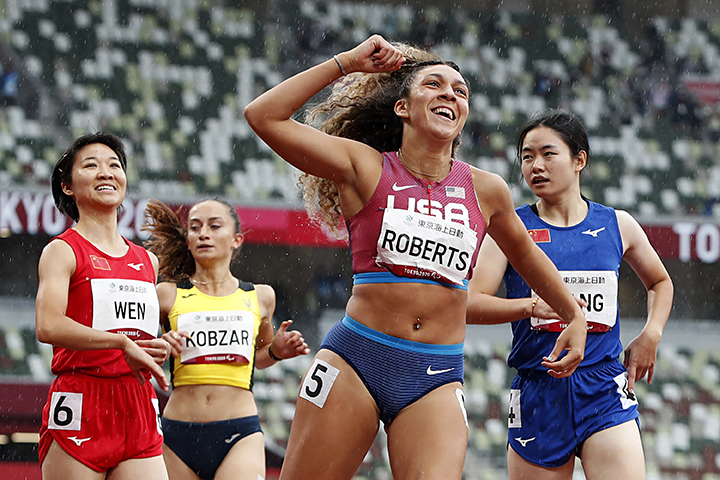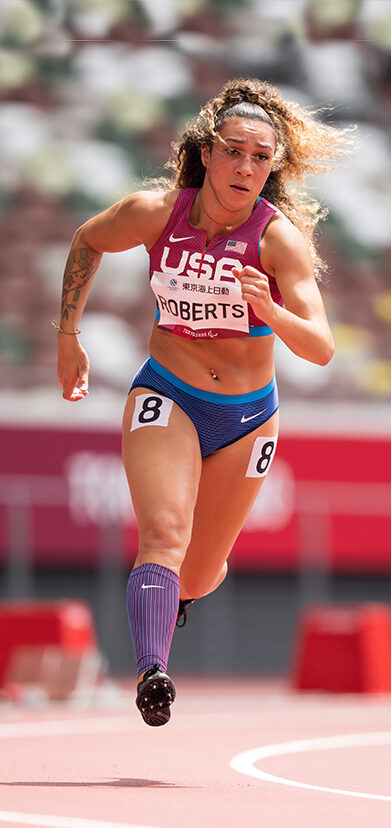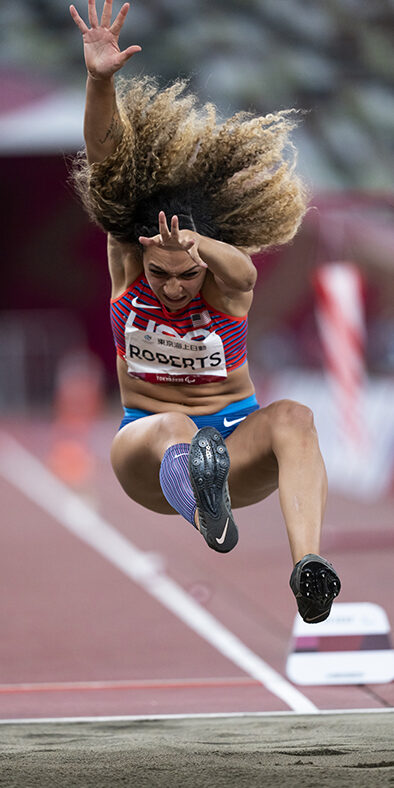Jaleen Roberts: Success and Sacrifice

For one of the world’s most accomplished athletes, nothing has come easy.
By Charles E. Reineke
It was raining as EWU student and Team USA Paralympian Jaleen Roberts settled into the starting blocks at Tokyo’s Olympic Stadium — a light but steady downpour, just like the PNW showers she’d trained in back home.
The 2020 Summer Paralympic Games — so dated due to a year-long pandemic delay — had already yielded Roberts a medal, silver, for her North American record-setting leap in the long jump. But now she was lining up for the 100 meters, arguably track and field’s most storied event.
Roberts was ready, confident. The prelims had gone exactly as planned. Here in the final she was in Lane 5, almost dead center in the nine-woman field, right where she wanted to be. The rain, too, was welcome, familiar, calming. She felt any pre-race anxieties melting away with every drop.

Roberts, who completed her bachelor’s degree in Eastern’s Department of Wellness & Movement Sciences in December, is one of the world’s top para athletes. Before arriving in Tokyo, she had proved her mettle in the two most recent World Para Athletics Championships, claiming a total of five medals, including gold in 2019’s 4×100 universal relay. Earlier this year she was ranked as the planet’s No. 1 long jumper.
But none of it had come easy: Not physically, not mentally. Her appearance in Tokyo for example, the culmination of nearly four years of focused, intensive training, almost ended before it began, a casualty of a cycle of depression so severe that Roberts, for a time, thought she would not survive it.
Born with cerebral palsy, Roberts has nonetheless excelled in competitive sports since childhood. Back in Kent, Washington, the Seattle suburb where she grew up, Roberts says she almost always found herself teamed up with, and competing against, “able-bodied athletes.” Never bothered her, she says.
“I started playing sports with the able-bodied kids when I was 4 years old,” says the now 23-year-old Roberts. “I began with soccer, then a bunch of sports.” By high school, again competing against able-bodied athletes, she excelled not only in soccer, but in wrestling and track. Especially track. It was at a state-level track meet that she first heard the pitch for para-sports from her eventual Paralympic coach, David Greig, development director and head coach for track and field at ParaSport Spokane, a local adaptive-sports organization with an impressive record of training champions.
Greig, who has been coaching female athletes with cerebral palsy for two decades, immediately recognized Roberts’ breakthrough talent. “The first time I saw her run and long jump — I still have it on video — I pulled out my phone and called the director of the USA Paralympic track and field program and said, ‘We’ve got something here. She’s functional, she’s fast, and she’s aggressive. She’s got the whole mix.’”
Though he was pretty much ready to sign her that day, Roberts wasn’t so sure she was buying what Greig was selling. “I was initially hesitant because I had never competed against other athletes with disabilities, I had only competed against able-bodied athletes,” Roberts says. “It wasn’t something I necessarily wanted to do; I never really wanted to highlight my disability — I’ve always seen that as a part of me that was ‘normal’ and ‘able.’ But after learning more about it, and understanding how competitive it was, I decided to try it out.”
Just six months after “trying it out,” Roberts was competing with Team USA in London.
“It was interesting how much of a sense of belonging it gave me,” she says of those first international meets. “I was surprised at how much it made me feel like I was part of something, just because there were so many people around me who were just like me — whether with my same disability, or a different one.”
After high school, Roberts made the decision to leave her hometown and move to Spokane, where she and Greig could more fully develop her potential. This meant being away from her mom, Kathleen, and her sister and brothers: Kaitlyn, Austin and Jordan. Roberts says her family have always been close, and leaving was tough.
“It really took me out of my comfort zone,” Roberts recalls. “I knew myself, and I knew my level of discipline. If I didn’t have a coach, I wouldn’t have just trained on my own. So I had to make the sacrifice.”
And it wasn’t just the travel-related classroom accommodations that impressed Roberts, it was the love EWU showed toward this accomplished Eagle.
Difficult as it was, moving to Spokane offered Roberts an advantage beyond proximity to training: It made attending Eastern an easy call.
“It’s true I didn’t initially move to Spokane to attend Eastern,” Roberts admits with a laugh, “I chose Spokane for training, and Eastern was there. I mean, I never heard anything bad about Eastern! It was just never a school I thought about attending because I didn’t want to be so far away from my family and friends.”
As it turns out, EWU was a great fit for Roberts, who, at the conclusion of her track and field career, plans to become an educator. During the school year Roberts says she was required to do a lot of traveling. Her instructors, she says, were not just understanding, they were also incredibly encouraging.
“I was really scared about how my professors were going to deal with me being away, as far as me completing my academic course requirements. But they’ve always all been very supportive… I remember I had a final exam for my rhythms and games class: We had to, like, come up with our own dance and do it at the end of the quarter. But I was competing in Europe, so I couldn’t be there to perform it in front of the class. She just had me submit it digitally: and there I was, out with my phone on our hotel balcony in Italy, doing my dance.”
And it wasn’t just the travel-related classroom accommodations that impressed Roberts, it was the love they showed toward this accomplished Eagle: “They would send emails out to all the other students keeping them updated on what I was doing, which I think is really cool,” she says. “It shows how proud they were to have a student who is doing this; who is in the Paralympics and traveling for Team USA.”
Perhaps even more consequentially, Roberts says Eastern’s faculty were also instrumental in helping her stay on track after she found herself struggling mentally — a dark period in her personal life about which Roberts has been courageously forthcoming.
She had begun her para-athletics career just a few months after the conclusion of the 2016 Olympic and Paralympic Games in Rio de Janeiro, Brazil. Since that time the travel, the competitions, the intense training schedule — hours each day, six days a week, while juggling a full-time schedule at Eastern — were all geared toward preparing Roberts for her Paralympic debut in Tokyo.
Then came Covid-19.
As a dazed world struggled to understand what was happening, things went from bad to worse with stunning speed. In January, rising international case numbers made clear the “novel coronavirus” was rapidly spreading from person to person, and would not be confined to China. In early February, global transportation restrictions began stranding travelers, and within weeks many international borders shut down completely. By mid-March the WHO had declared a global pandemic.

For a while, Japanese and Olympic officials put on a brave face, saying, as one news account put it, that the Games “would be the balm the world needs to show victory over the coronavirus pandemic.” But then, on March 23, Prime Minister Shinzo Abe of Japan announced that the Games were off, supposedly postponed, though many in Japan loudly advocated for their outright cancelation.
The news hit Roberts hard. The punishing workouts, the endless training, the exhausting travel, the separation from family and friends: suddenly it all seemed like a cruel joke, a virus-concocted mockery of everything that defined her. She felt her ambitions dissolving into air; her dreams vanishing before her eyes. Then came word that one of her closest friends was dead at age 23, apparently from suicide. For Roberts, who had long battled anxiety and depression, it was almost too much to bear.
At a particularly low moment, afraid that she might harm herself, Roberts checked into a psychiatric hospital. “At some points, I genuinely didn’t think that I would make it,” she confided to reporter Danamarie McNicholl of Spokane’s KREM2 during a February interview.
Coach David Greig pauses, then gives a heavy sigh when he recalls Roberts’ ordeal. During the four years leading up to the Games, he says, the focus had always been on what Greig calls “the plan” — “Tokyo, medaling, executing what needed to be done when that gun went off, or when that long jump commenced… With Covid-19, with Tokyo disappearing, all that stuff, things changed.”
Greig says he tried to help by “peeling back the layers,” digging deep to identify the sources of Roberts’ destructive stress. “I remember there was text conversation we had. I was on the coast, trying to get some R&R. She was really struggling. I asked her, ‘Why? Why do you want to do this?’ It basically got down to her saying ‘I want to be that girl, that woman, that other girls with disabilities can look up to. Because I didn’t have that.’ I’m, like, okay. Let’s go from there.”
At Eastern, Carri Kreider, an associate professor and program director for health and physical education, also remembers Roberts’ battle as something of a milestone along her road to something greater. “Our Health and Physical Education Program is like one large family,” Krieder says. “While Jaleen’s Paralympic success is amazing, so is her ability to overcome the struggles she has had with mental health… We would not give up on her. And, more importantly, we would not let her give up on herself.”
It was, thankfully, a short, successful hospital stay. Roberts emerged more determined than ever to keep training hard for Tokyo, willing herself to believe the Games would eventually be held. But the frightening episode has stayed with her, adding yet another incentive to succeed: Using success not only to encourage others with physical disabilities, but also those who may be struggling with mental health challenges.
“I’ve always been super transparent about my mental health journey, just because I feel like it’s something that needs to be more normalized, especially in the athletics community,” Roberts says. “People think that athletes in some way are exempt from mental health issues — suicide, depression, anxiety — and we’re not. I hope that my experience might help other athletes, and everybody in general, understand that it’s OK to struggle. It’s OK to reach out and speak up when you need help.”
The Tokyo Games did, of course, go on. And as she boarded the jumbo jet bound for Japan, Roberts knew she was ready. Convinced, she says, that she had left nothing on the table in preparation for track and field’s biggest stage.
To ensure competitive fairness, athletes at the Paralympics are classed according to the nature of their impairments. Track and field athletes such as Roberts, who live with co-ordination conditions involving hypertonia (muscle tightness and reduced stretching capacity) ataxia (a loss of muscle control affecting voluntary movements) and athetosis (muscle contractions that sometimes cause involuntary movements) compete in “Running Tracks and Jumps,” categories T35-38.
Roberts is a T37 athlete, a category where, according to World Para Athletics, competitors have “moderate hypertonia, ataxia or athetosis in one half of the body. The other side of the body may be minimally affected but always demonstrates good functional ability in running.”
After the long flight, Roberts settled in to her accommodations at Yokota Air Base, the U.S. Air Force facility in Tokyo where the 70-member Team USA would spend the week before the Games. The extra time at Yokota allowed Roberts to recover from jet-lag and get acclimatized before getting down to business.
Heat 1 of the 200-meter sprint was to be Robert’s first event, held on the third day of the 12-day-long Games. She was highly ranked, but wasn’t a favorite against the talent-stacked field. She ran well, however, finishing third in her heat. It was good enough to qualify for the final, but with a time that put her well behind the eventual medalists. She wasn’t in the least bit disappointed. In fact, Roberts says, getting that first race in the books provided a big boost of confidence. It also didn’t hurt, jitters-wise, that the stands of the enormous stadium were largely empty due to Japan’s strict Covid-19 protocols.
More important than the lack of fans, however, was simply feeling comfortable. Feeling like she belonged, not just at the Games but on the podium. Roberts says that as she entered the stadium for the T37 long jump, the second of her three scheduled events, she was more than relaxed. She was psyched.
“With a big competition like that, you’re obviously used to having people in the stands,” she says. “But as I’ve reflected back on the whole Games, I think it made me a little bit less nervous than I would normally be, just because it made it all feel like a smaller event.”
More important than the lack of fans, however, was simply feeling comfortable. Feeling like she belonged, not just at the Games but on the podium. Roberts says that as she entered the stadium for the T37 long jump, the second of her three scheduled events, she was more than relaxed. She was psyched.
“After the 200-meter, most of my nerves were gone,” she says. “Obviously, you still get the stress that happens right before your event — like, ‘Woo, I’m about to go out there’ — but no, seriously, I was probably in my best head-space going into the long jump that I’ve ever been in for any event at any competition.”
Reaching that level of comfort was no small achievement. In the long jump, athletes sprint down a 40-meter-long “runway” (the approach) which terminates in a 20 cm (7.8 inch) wide “take-off board.” As they near the board, long-jumpers must quickly condense their stride and heave themselves airborne before reaching the foul line at board’s end. Because even a toe on the line disqualifies the jump, the temptation is to launch early. Leaving sooner, of course, prevents disqualifications. But it shaves crucial inches off a jumper’s final distance.
Roberts says that previous to the Games, she had been struggling to bring her approach and launch into sync — perhaps the most crucial part of this demanding event — and it had weighed on her mentally.
“I had been working on it for years,” she says of her approach, “just getting on the board; taking off from the board: I would always take off behind the board. But over the last couple of months I finally got it down. In practice I was consistent with it; at a competition before the Games, I was consistent with it. That helped me feel more confident going in. I was able to have fun, instead of thinking so much that: ‘You’re not going to get on the board; you’re not going to get on the board.’”

“I just focused on talking really positively to myself,” she adds. “I really, really, really try to have that voice between my ears to be my friend and not my enemy.”
And so it was on Day 5 of the Games, as Roberts’s perfect technique on the second of her five jumps set a new North American record of 4.65 meters (15.25 feet) and earned her a silver medal. It was an exultant moment, but there was little time for celebration. The 100-meter was on the horizon. She was determined to make the most of it.
Roberts says that before the long-jump, she was so pumped that Greig urged her to chill. “He’s like, ‘Jaleen, please go over there and sit down. You’re wasting too much energy!’” She recalls feeling more ambivalence headed into the 100.
“To be completely honest, I was not super confident going into it. I just wasn’t super happy with the times I had been running during the season… I knew my ranking [No. 3 in the world], but I was, like, ‘I’m not even sure I’m going to place here. I’m just going to run it; see what happens.’”
That changed after her qualifying race. Roberts finished second with a time of 13.41 — just .15 seconds behind China’s Xiaoyan Wen — easily qualifying for the next-day’s final. “After that, I felt really good,” says Roberts. “I was glad that it was the next morning. I think the adrenaline was carrying over.”
When that rainy morning dawned, Roberts remembers she was again in the “positive head space” that bodes well for elite athletes. “It’s weird, because the races where I feel the most relaxed are the races that I run the fastest. But in your head, you actually feel like you’re running slow. It’s because you’re not tensing up.” (Tensing up isn’t good for any athlete, but for those with cerebral palsy it’s especially troublesome. “It’s just the nature of cerebral palsy,” says Greig. “If you’re stressed out, your body reflexively tightens.”)
Video clips from NBC Sports show Roberts looking intensely focused as she approached the blocks. Runners in the 100 typically internalize a litany of technical points that will help propel them forward. Feet set, body aligned. React to—don’t anticipate — the gun. Keep long out of the blocks, ease into the upright position, stay low and efficient over the first 25 meters.
For Roberts it was all about keeping positive, trusting her abilities. “I was ready to go. I was ready to medal.”
Crouched in the blocks to her right was Wen, two-time 100-meter gold medalist and the world record holder. To Roberts’ left was Jiang Fenfen, another Chinese athlete with a reputation for speed and efficiency. Greig was in the stands above the track, peering down nervously. “Honestly, I was thinking bronze,” he says, “because Jaleen had never touched the Chinese girls.”
Roberts settled into the blocks, head down, hair draped across her face like a veil.
The gun sounded. Roberts got away clean and fast. “One of her best starts ever,” Greig says. Still, after the first couple of strides she found herself looking at the backs of her two closest rivals. “Jaleen Roberts has some work to do!” said NBC’s Bill Spaulding during his call.
“I had thought through the race going in: get out of the blocks hard, but stay low, and then transition up instead of standing right up. So I just worked it through. And as soon as I got to my top end, I think I just got a little push. I don’t know… I just felt some burst of energy kicked in.”
Indeed. By the 50-meter mark the race had become a three-woman event: Wen leading, Jiang a half-stride behind her with Roberts in third but closing fast. At this point, with all three runners at peak speed, the race became a contest of attrition: Who could maintain the pace?
As the finish approached, it was clear that Wen would not be denied another gold medal. But Roberts kept powering forward; pushing, gaining ground. “I’ve learned over the years not to tense up when I see people passing me — that used to be one of the areas I struggled with,” Roberts says. “I knew they were going to go out hard, because they’re phenomenal athletes. So I just stayed calm and relaxed.”
At 75 meters, Roberts says she knew she would be medaling, “because I couldn’t see the field in my peripheral vision,” she says. But the color of that medal was very much up in the air.
“I could see one of the Chinese athletes in front of me, but I didn’t think there was enough time left in the race for me to catch up to her,” she says. “But then I saw the other Chinese athlete on my left. I thought, ‘We are way too close. There is no way I’m going to lose to her.’”
The finish could not have been tighter, but Roberts inched ahead at the end.
“In the stands, with 10 meters to go, I just started screaming, ‘GO! GO!’ It just came out of nowhere, I was like ‘Gooooooo! GO J!’ I could see she was closing. It was awesome. People around me were, like, ‘What is wrong with this guy?’”
“When I saw my name and ‘silver’ on the board,” she says, “I freaked out. I started bawling.”
Greig’s voice catches with emotion as he recalls the race’s finish, one he says was “the highlight of my coaching career.”
“In the stands, with 10 meters to go, I just started screaming, ‘GO! GO!’ It just came out of nowhere, I was like ‘Gooooooo! GO J!’ I could see she was closing. It was awesome. People around me were, like, ‘What is wrong with this guy?’”
Wen’s time of 13-seconds flat was a new world record. Roberts second-place time of 13.16 set the American and North American records. After the race the two competitors, who count themselves as friends off the track, joined up with Jiang to pose together, smiling.
It was a classic moment of sporting solidarity, a reminder of how the Olympic spirit is meant to bring rivals — both personal and political — together in shared appreciation. It also speaks of the power of sport to encourage, to motivate, to inspire. For Jaleen Roberts, an Eastern student whose Paralympic dreams were seemingly upended by a global pandemic, a young person who experienced the tragic death of her best friend and depression-shrouded days where she could not will herself out of bed, this was the true power of standing on the podium.
“It means that there are girls around the world watching on TV, and that I didn’t disappoint them,” Roberts says. “It means that I was able to show that you can move beyond all this adversity and still come out with success.”
These days, Roberts has been student teaching in San Diego — the last requirement for finishing up her degree at EWU — while working with Greig’s coaching colleague Kris Mack at the U.S. Olympic and Paralympic Committee’s Elite Athlete Training Center in nearby Chula Vista. The past few months have been a whirlwind, she says, but she is keeping her focus on what really matters.
“I’ve always tried to find deeper meaning in things,” Roberts says. “It’s really nice to have finally done this thing I’ve always wanted to do, and to have the impact that I’ve always wanted to have. That I get to continue having an impact means a lot to me, too. That’s not something that’s going to stop just because the Games are over.”
Filed Under: Alumni Profiles Athletics Featured Sports Students
Tagged With: Fall/Winter 2021


